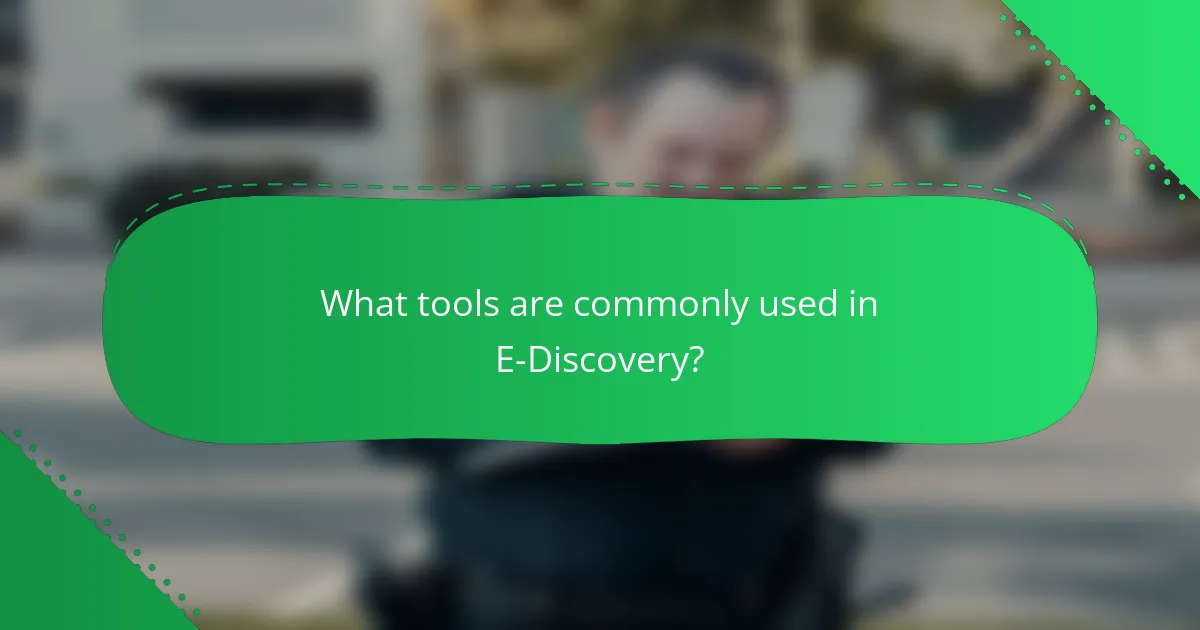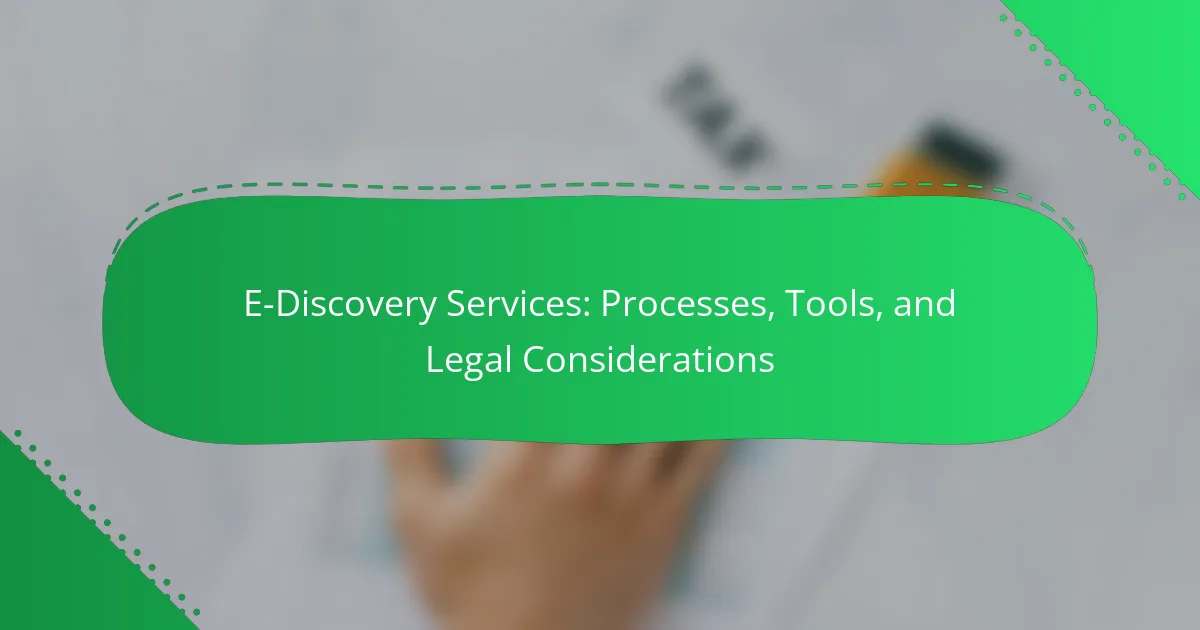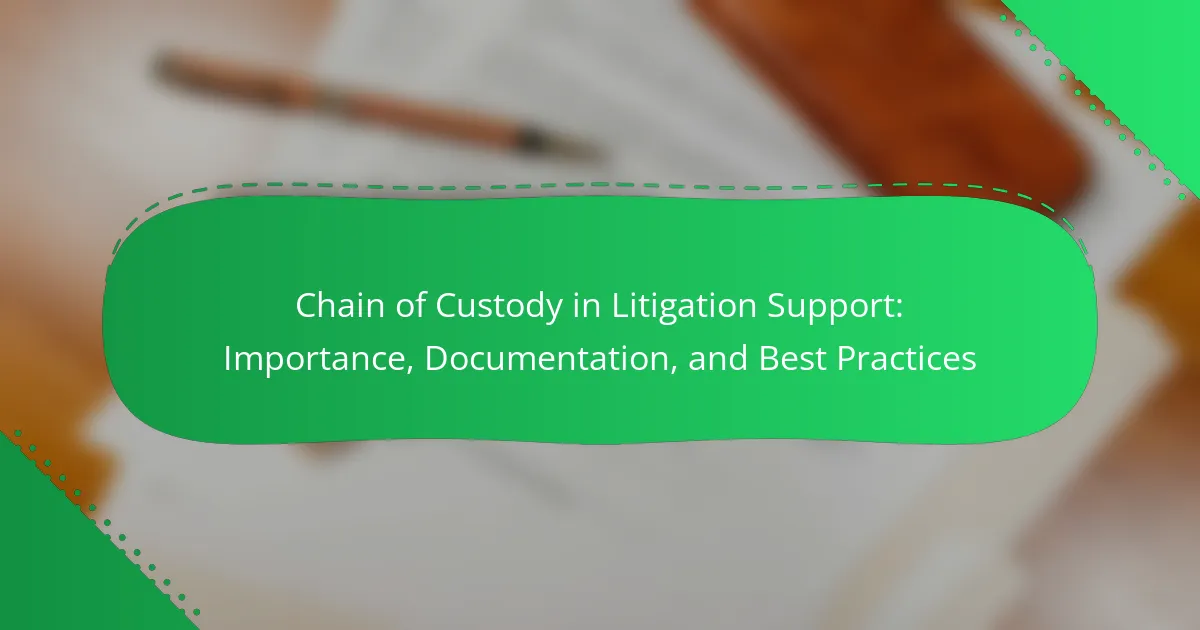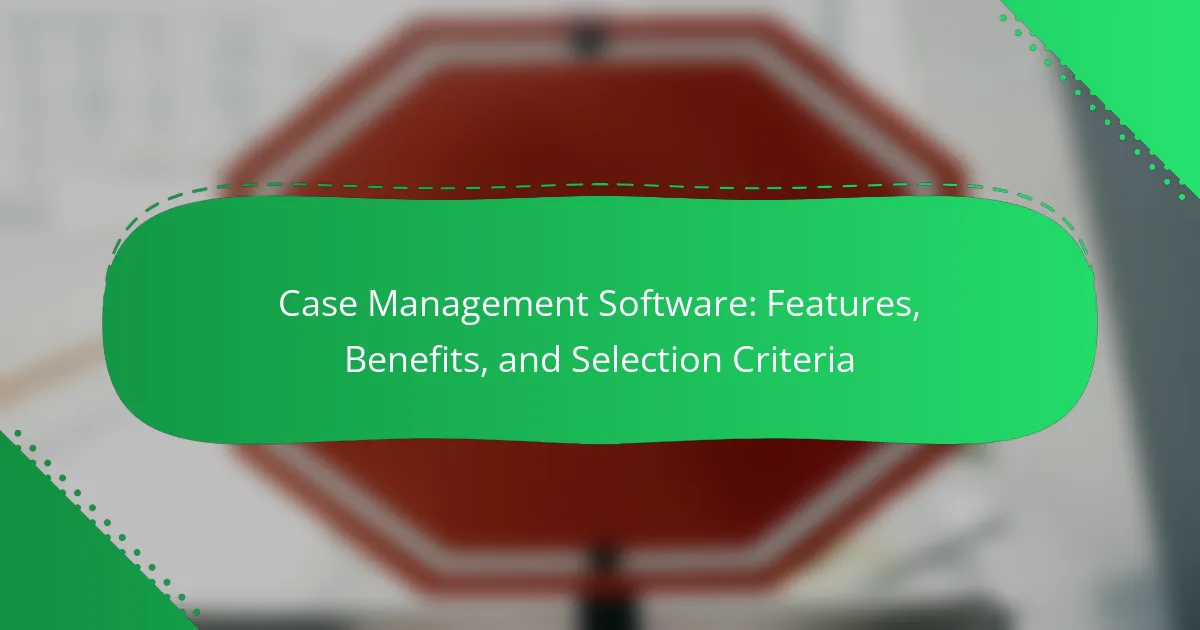E-Discovery services encompass the identification, collection, and analysis of electronic data for legal purposes, playing a crucial role in litigation, investigations, and compliance. This process involves extracting relevant information from diverse digital formats, such as emails, documents, and social media, often utilizing specialized software tools like Relativity, Logikcull, and Everlaw to enhance efficiency and accuracy. Legal considerations surrounding E-Discovery include adherence to the Federal Rules of Civil Procedure, maintaining the integrity of evidence through proper chain of custody, and ensuring compliance with privacy regulations. Understanding these processes, tools, and legal implications is essential for organizations to effectively manage E-Discovery workflows and mitigate potential legal risks.

What are E-Discovery Services?
E-Discovery services refer to the process of identifying, collecting, and analyzing electronic data for legal purposes. These services are essential in litigation, investigations, and compliance matters. They facilitate the discovery of relevant information stored in various digital formats. Common data sources include emails, documents, databases, and social media. E-Discovery services often utilize specialized software tools to streamline data processing and review. These tools help legal teams efficiently manage large volumes of information. The process ensures compliance with legal standards and can significantly impact case outcomes. E-Discovery is governed by rules and regulations, such as the Federal Rules of Civil Procedure in the United States.
How do E-Discovery Services function in legal contexts?
E-Discovery services function by collecting, processing, and analyzing electronic data for legal cases. These services help legal teams identify relevant information from various digital sources. Data sources include emails, documents, social media, and databases. E-Discovery tools automate the search and retrieval of this information. They apply algorithms to filter and categorize data based on legal requirements. This process ensures compliance with regulations and reduces the volume of data for review. Legal professionals use the extracted information to build cases or defend against claims. The effectiveness of E-Discovery services is supported by their ability to manage large datasets efficiently.
What are the key stages involved in the E-Discovery process?
The key stages involved in the E-Discovery process are identification, preservation, collection, processing, review, analysis, and production. Identification involves determining the relevant data sources. Preservation ensures that the data is protected from alteration or deletion. Collection refers to gathering the identified data from its sources. Processing transforms the collected data into a format suitable for review. Review involves examining the data for relevance and privilege. Analysis assesses the data for insights and patterns. Production is the final stage where the relevant data is delivered to the requesting party. Each stage is crucial for maintaining the integrity and legality of the E-Discovery process.
What types of data are typically involved in E-Discovery?
E-Discovery typically involves various types of data. These include emails, documents, and spreadsheets. Social media content is also relevant in E-Discovery. Additionally, audio and video recordings may be involved. Metadata associated with files is crucial for context. Text messages and instant messages are often collected as well. Cloud storage data is increasingly significant in investigations. Lastly, database records can also be part of the E-Discovery process.
What are the benefits of using E-Discovery Services?
E-Discovery services provide several key benefits. They streamline the process of collecting and reviewing electronic data. This efficiency saves time and reduces costs for legal teams. E-Discovery tools enhance accuracy in identifying relevant information. They also ensure compliance with legal standards and regulations. Additionally, these services can improve case outcomes through better data management. According to a study by the Electronic Discovery Reference Model (EDRM), effective E-Discovery can reduce litigation costs by up to 30%. Overall, E-Discovery services optimize legal workflows and enhance the quality of evidence.
How can E-Discovery Services enhance legal efficiency?
E-Discovery services enhance legal efficiency by streamlining the process of gathering and analyzing electronic evidence. These services automate data collection from various digital sources, reducing manual labor. They also employ advanced search algorithms to quickly locate relevant information. This speeds up the review process, allowing legal teams to focus on critical aspects of cases. According to a study by the RAND Corporation, effective e-discovery can reduce costs by up to 50%. Additionally, e-Discovery services provide secure data management, ensuring compliance with legal standards. This minimizes the risk of data breaches and legal penalties. Overall, e-Discovery services significantly improve the speed and accuracy of legal proceedings.
What cost savings can be achieved through E-Discovery?
E-Discovery can achieve significant cost savings for organizations. It reduces the time and resources needed for document review. Automated tools can process large volumes of data efficiently. This minimizes the need for extensive manual labor. A study by the RAND Corporation found that E-Discovery can reduce costs by up to 75%. Early case assessment through E-Discovery helps identify relevant documents quickly. This prevents unnecessary expenses related to irrelevant data. Overall, E-Discovery streamlines the legal process, leading to lower litigation costs.

What tools are commonly used in E-Discovery?
Commonly used tools in E-Discovery include Relativity, Logikcull, and Everlaw. These tools facilitate the identification, collection, and review of electronically stored information. Relativity is known for its robust analytics and review capabilities. Logikcull offers a user-friendly interface for automated document review. Everlaw integrates case management with powerful search functions. Other notable tools include Zapproved and Exterro, which assist with legal hold and compliance processes. These tools are essential for efficient E-Discovery workflows in legal settings.
How do E-Discovery tools facilitate data management?
E-Discovery tools facilitate data management by automating the process of identifying, collecting, and reviewing electronic information. They streamline the retrieval of relevant data for legal cases. These tools enhance efficiency by reducing the time required for manual searches. E-Discovery tools also improve accuracy in data collection, minimizing the risk of human error. They support various file formats and data sources, ensuring comprehensive coverage. Additionally, they offer secure storage and management of sensitive information. The use of advanced algorithms and analytics aids in sorting through large volumes of data quickly. Overall, E-Discovery tools are essential for effective data management in legal contexts.
What are the features of leading E-Discovery software?
Leading E-Discovery software typically includes features such as data processing, document review, and analytics. Data processing allows for the ingestion and indexing of large volumes of electronic data. Document review features enable users to organize, tag, and annotate documents efficiently. Analytics capabilities provide insights through data visualization and trend analysis. Additionally, advanced search functionalities help users locate relevant information quickly. Security features ensure the protection of sensitive data during the e-discovery process. Integration with existing systems streamlines workflow and enhances usability. Compliance tools assist in adhering to legal standards and regulations. These features collectively enhance the efficiency and effectiveness of e-discovery efforts.
How do these tools support data analysis and review?
E-Discovery tools support data analysis and review by automating the identification, collection, and examination of electronic data. These tools streamline the process of searching for relevant information within large datasets. They utilize advanced algorithms to filter and categorize data based on predefined legal criteria. This capability significantly reduces the time required for manual review. Additionally, these tools provide visual analytics to help users interpret complex data patterns. For example, they can generate timelines and charts that highlight key information. The automation of repetitive tasks allows legal teams to focus on strategic decision-making. Overall, E-Discovery tools enhance efficiency and accuracy in the data analysis and review process.
What role do cloud-based solutions play in E-Discovery?
Cloud-based solutions streamline the E-Discovery process by providing scalable storage and efficient data management. They enable legal teams to access and analyze large volumes of electronic data remotely. This accessibility enhances collaboration among team members across different locations. Additionally, cloud solutions often include advanced tools for data processing and analytics. These tools improve the speed and accuracy of document review. According to a report by Gartner, cloud-based E-Discovery tools can reduce costs by up to 30% compared to traditional methods. Overall, cloud-based solutions significantly enhance the efficiency and effectiveness of E-Discovery efforts.
What are the advantages of using cloud solutions for E-Discovery?
Cloud solutions for E-Discovery offer several advantages. They provide scalable storage options for large volumes of data. This flexibility allows organizations to manage varying data sizes efficiently. Cloud solutions also enhance collaboration among legal teams. Multiple users can access documents simultaneously from different locations. Additionally, cloud solutions often include advanced analytics tools. These tools facilitate quicker data processing and review. Security features in cloud solutions help protect sensitive information. Many providers comply with industry standards for data protection. Cost-effectiveness is another key advantage. Organizations can reduce infrastructure costs by using cloud services. Overall, cloud solutions streamline the E-Discovery process significantly.
How do security measures in cloud E-Discovery tools protect sensitive data?
Security measures in cloud E-Discovery tools protect sensitive data through encryption, access controls, and compliance protocols. Encryption secures data at rest and in transit, making it unreadable to unauthorized users. Access controls limit data visibility to authorized personnel only. Multi-factor authentication enhances user verification, reducing the risk of unauthorized access. Regular security audits and vulnerability assessments identify potential threats. Compliance with regulations like GDPR and HIPAA ensures that data handling meets legal standards. Together, these measures create a robust framework for safeguarding sensitive information in E-Discovery processes.

What legal considerations should be taken into account with E-Discovery?
Legal considerations in E-Discovery include compliance with relevant laws, such as the Federal Rules of Civil Procedure. Organizations must ensure that data collection methods adhere to privacy regulations. Preservation of electronically stored information (ESI) is critical to avoid spoliation claims. Chain of custody must be maintained to validate the integrity of evidence. Additionally, parties should be aware of potential costs associated with E-Discovery processes. Courts may impose sanctions for failure to comply with E-Discovery obligations. Understanding jurisdictional differences in E-Discovery laws is also essential. These considerations help mitigate legal risks during litigation.
What are the compliance requirements for E-Discovery?
E-Discovery compliance requirements involve adherence to legal standards for electronic data management. Organizations must ensure they preserve relevant data when litigation is anticipated. This includes maintaining data integrity and preventing spoliation. Legal hold notices should be issued to prevent data destruction. The Federal Rules of Civil Procedure outline specific obligations for data collection and production. Compliance also requires that data is collected in a forensically sound manner. Additionally, organizations must ensure they meet privacy regulations, such as GDPR or HIPAA, during the e-Discovery process. Failure to comply can result in legal penalties or adverse judgments.
How do different jurisdictions impact E-Discovery practices?
Different jurisdictions significantly impact E-Discovery practices through variations in laws and regulations. Each jurisdiction may have distinct rules governing the collection, preservation, and production of electronic evidence. For instance, the Federal Rules of Civil Procedure in the United States provide specific guidelines that may differ from those in European Union countries, which adhere to the General Data Protection Regulation (GDPR). These differences can affect how data is accessed and shared across borders. Additionally, some jurisdictions may impose stricter privacy protections, influencing the scope of E-Discovery. Understanding these jurisdictional nuances is crucial for compliance and effective legal strategies in E-Discovery processes.
What are the potential legal risks associated with E-Discovery?
The potential legal risks associated with E-Discovery include data privacy violations, spoliation of evidence, and non-compliance with legal holds. Data privacy violations can occur if sensitive information is improperly accessed or disclosed during the E-Discovery process. Spoliation of evidence happens when relevant electronic data is deleted or altered, which can lead to legal penalties. Non-compliance with legal holds can result in sanctions if parties fail to preserve relevant data as required by law. These risks underscore the importance of adhering to established E-Discovery protocols and regulations.
How can organizations ensure ethical E-Discovery practices?
Organizations can ensure ethical E-Discovery practices by establishing clear policies and guidelines. These policies should comply with legal standards and industry best practices. Regular training for employees on ethical considerations is essential. Organizations should also implement robust data protection measures to safeguard sensitive information. Transparency in communication with stakeholders about E-Discovery processes is crucial. Additionally, organizations must conduct regular audits to assess compliance with ethical standards. Engaging qualified legal counsel can provide further guidance on ethical E-Discovery practices. By adhering to these measures, organizations can maintain integrity throughout the E-Discovery process.
What guidelines should be followed to maintain data integrity?
To maintain data integrity, follow established guidelines that ensure accuracy and consistency. Implement access controls to limit who can modify data. Regularly back up data to prevent loss from corruption or system failures. Use data validation techniques to check for errors during input. Monitor data usage and changes to detect unauthorized alterations. Encrypt sensitive data to protect it from unauthorized access. Conduct regular audits to assess data integrity and compliance. Document all processes and changes to maintain a clear history of data handling.
How can organizations mitigate the risks of data breaches during E-Discovery?
Organizations can mitigate the risks of data breaches during E-Discovery by implementing robust security protocols. These protocols include data encryption to protect sensitive information. Access controls should be enforced to limit who can view or handle data. Regular security audits can identify vulnerabilities in the E-Discovery process. Training employees on data protection best practices is essential to reduce human error. Utilizing secure E-Discovery tools that comply with industry standards enhances data security. Establishing a clear incident response plan prepares organizations for potential breaches. According to a report by the Ponemon Institute, organizations with comprehensive security measures can reduce the likelihood of data breaches significantly.
What best practices should be adopted for effective E-Discovery?
Effective E-Discovery requires a structured approach to manage electronically stored information. Organizations should implement a clear E-Discovery plan that outlines roles and responsibilities. Early case assessment is crucial for identifying relevant data quickly. Utilizing advanced tools for data collection and processing enhances efficiency. Regular training for legal and IT teams ensures compliance with legal standards. Data security measures must be in place to protect sensitive information during the E-Discovery process. Collaboration between legal and IT departments streamlines workflows and reduces risks. Documenting all E-Discovery processes is essential for maintaining a clear audit trail.
How can proper planning improve E-Discovery outcomes?
Proper planning can significantly enhance E-Discovery outcomes. It establishes a clear framework for identifying relevant data. This includes defining the scope and objectives of the E-Discovery process. Effective planning helps in selecting the right tools and technologies for data collection. It also streamlines communication among legal teams, IT departments, and external vendors. By anticipating potential challenges, organizations can mitigate risks associated with data management. According to the 2021 E-Discovery Trends Report, organizations with a structured planning approach saw a 30% reduction in review costs. This demonstrates that proper planning leads to more efficient and cost-effective E-Discovery processes.
What are common pitfalls to avoid in the E-Discovery process?
Common pitfalls to avoid in the E-Discovery process include inadequate planning and scope definition. Failing to establish clear objectives can lead to irrelevant data collection. Overlooking the importance of data preservation can result in spoliation issues. Not utilizing appropriate technology may hinder efficient data processing. Additionally, neglecting to train staff on E-Discovery tools can cause operational inefficiencies. Miscommunication between legal and IT teams often leads to misunderstandings about data handling. Lastly, ignoring compliance with legal standards can result in sanctions or unfavorable outcomes. Each of these pitfalls can significantly impact the effectiveness and legality of the E-Discovery process.
E-Discovery services are critical processes in the legal field that involve identifying, collecting, and analyzing electronic data for litigation, investigations, and compliance. The article covers the stages of the E-Discovery process, types of data involved, and the benefits of using specialized tools to enhance legal efficiency and reduce costs. It also addresses legal considerations, compliance requirements, and best practices for effective E-Discovery, emphasizing the importance of data integrity and security measures. Additionally, the article highlights the role of cloud-based solutions and the potential legal risks associated with E-Discovery practices.



